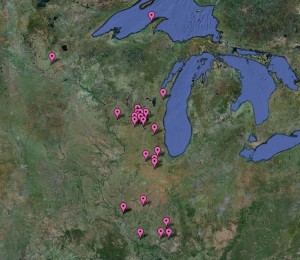NEWS
Wild Warner has obtained data showing that Canada Geese banded in Warner Park in 2007 have been hunted in six states, some more than 400 miles away. Of the original 132 banded by Wisconsin DNR, 42 have been shot by hunters, 9 were killed by Dane County Airport, and one skeleton was found. USGS Banding Lab officials call this “a remarkably high encounter rate.”

The data, mapped here, indicates that hunting has been a successful management tool for the geese, and raises new issues in the debate over managing geese in Madison parks.
Here is Wild Warner’s press release:
September 21, 2010
Facts:
1. On June 25, 2007, the Wisconsin DNR banded 132 Canada Geese in Warner Park. Wild Warner recently obtained “encounter data” on these geese from the federal USGS Bird Banding Laboratory in Maryland which keeps records on banded birds. Encounter data is recorded when a hunter, wildlife manager or other person who finds an animal, calls the lab or reports the finding online.
2. Between 2007 and 2009, the Dane County Regional Airport asked the WDNR to conduct another banding operation in Warner Park “and to use neck collars in an attempt to identify local resident birds through a nonlethal process” (see Warner Park Goose Round Up Data Sheet). According to the same airport source: “DCRA [airport] was advised the WDNR will no longer conduct banding operations of any type in Warner Park because they want to focus their banding operations on huntable populations of Canada geese.”
3. The USGS Bird Banding Laboratory data shows that the Warner geese were/are huntable, and in fact, were hunted. By the end of 2009, 52 of the original 132 banded geese were dead, 81% of these shot by hunters. The BBL called it “a remarkably high encounter rate.” Of the total 52 dead, this is the breakdown:
-42 were shot and hunted in six states (WI, MN, MI, IL, IN, and Kentucky). See map.
-9 were shot by the airport with depredation permits.
-1 skeleton was found (cause of death unknown).
4. In April of 2010, the airport and the city of Madison asked the Parks Commission to approve a roundup and kill of the Warner Geese.
5. At least some Warner Geese are long-distance migrators. They were found as close as five miles (airport) and over 400 miles away: MN, MI, IL, IN, and Kentucky. See map.
This data raises the following questions for policymakers:
1. Why did the WDNR decide to band the Warner Geese in 2007?
2. How did WDNR determine that this population was not “huntable”?
3. Since hunting appears to be working as a management tool for urban geese, should hunting seasons be extended to control these populations?
4. New geese have already come to Warner Park and replaced the original geese. Does this mean that a roundup would not work? (In Prospect Park, Brooklyn, the USDA conducted a Canada Geese roundup in July, killing 400 geese. Two months later, there are already over 100 geese back in Prospect Park.)
5. What does the distribution data mean (where the geese were found)? Is this a typical distribution pattern? Does it have any implications for Madison’s other “resident” geese?
6. Some Warner geese are long-distance migrators. Are they subject to any federal protection?
7. What is the WDNR’s responsibility to Warner Park and its geese since the WDNR still owns part of Warner Park? What resources does the agency need to be able to conduct the study that the airport requested?
You must be logged in to post a comment.